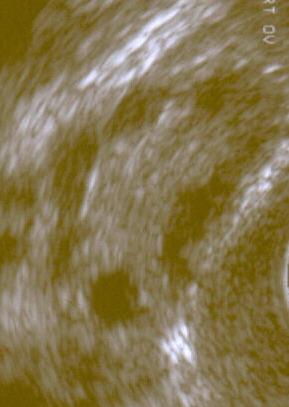Polycystic ovary syndrome
ovary syndrome (PCOS) bụ usoro mgbaàmà n'ihi androgens dị elu (homonụ nwoke) n'ime ụmụ nwanyị. Ihe ịrịba ama [1] mgbaàmà nke PCOS gụnyere Oge ịhụ nsọ na-adịghị mma ma ọ bụ na ọ dịghị, oge dị arọ, oke ahụ na ntutu ihu, acne, ihe mgbu pelvic, ihe isi ike ime ime, na ntụpọ nke Akpụkpọ ahụ siri ike, nke gbara ọchịchịrị, nke na-acha odo odo. [2] Ọnọdụ emetụtara gụnyere ụdị ọrịa shuga 2, oke ibu, apnea na-egbochi ụra, ọrịa obi, nsogbu ọnọdụ uche, na ọrịa kansa endometrial.
PCOS [3] n'ihi njikọta nke ihe ndị metụtara mkpụrụ ndụ ihe nketa na gburugburu ebe obibi. [4] [5] Ihe n[6] dị ize ndụ gụnyere oke ibu, enweghị mmega ahụ, na akụkọ ezinụlọ nke onye nwere ọnọdụ ahụ. Nnyocha ahụ dabere [2] abụọ n'ime nchọpụta atọ ndị a: enweghị ovulation, ọkwa androgen dị elu, na ovarian cysts. Enwere ike ịchọpụta cysts site [7] ultrasound. [7]-Ọnọdụ ndị ọzọ na-emepụta mgbàmà ndị yiri ya gụnyere hyperplasia adrenal, hypothyroidism, na ọkwa dị elu nke prolactin
PCOS enweghị ọgwụgwọ [8] ọ na-erule afọ 2020. [9] nwere ike ịgụnye mgbanwe ndụ dịka ibu ibu [10] mmega ahụ. [11]Ọgwụ mgbochi ọmụmụ nwere ike inye aka n'imeziwanye oge, uto ntutu isi gabigara ókè, na acne. [11]Metformin na anti-androgens nwekwara ike inye aka. Enwere ike iji ọgwụgwọ ndị ọzọ [11] usoro iwepụ ntutu mee ihe. Mgb[12] ndị a na-eme iji melite ọmụmụ gụnyere ibu ibu, clomiphene, ma ọ bụ metformin. [12] vitro fertilization na-eji ụfọdụ ndị usoro ndị ọzọ na-adịghị arụ ọrụ.
PCOS bụ Nsogbu endocrine kachasị n'etiti ụmụ nwanyị nọ n'agbata afọ 18 na 44. [13] [14][6] na-emetụta ihe dịka 2% ruo 20% nke ọgbọ a dabere n'otú e si kọwaa ya. Mgbe mmadụ [2]-enweghị ike ịmụ nwa n'ihi enweghị ovulation, PCOS bụ ihe a na-ahụkarị. Nkọw[15] Nkọwa mbụ amara nke ihe a ghọtara ugbu a dị ka ụbọchị PCOS site na 1721 na Italy.
Edensibia
dezie- ↑ What are the symptoms of PCOS? (05/23/2013). National Institute of Child Health and Human Development (NICHD). Archived from the original on 3 March 2015. Retrieved on 13 March 2015.
- ↑ 2.0 2.1 2.2 Polycystic Ovary Syndrome (PCOS): Condition Information. National Institute of Child Health and Human Development (January 31, 2017). Archived from the original on 22 October 2018. Retrieved on 19 November 2018.
- ↑ (2015) "Scientific Statement on the Diagnostic Criteria, Epidemiology, Pathophysiology, and Molecular Genetics of Polycystic Ovary Syndrome". Endocrine Reviews 36 (5): 487–525. DOI:10.1210/er.2015-1018. PMID 26426951.
- ↑ (2016) "Genetic, hormonal and metabolic aspects of PCOS: an update". Reproductive Biology and Endocrinology 14 (1): 38. DOI:10.1186/s12958-016-0173-x. PMID 27423183.
- ↑ (2006) "The role of genes and environment in the etiology of PCOS". Endocrine 30 (1): 19–26. DOI:10.1385/ENDO:30:1:19. PMID 17185788.
- ↑ 6.0 6.1 How many people are affected or at risk for PCOS?. Eunice Kennedy Shriver National Institute of Child Health and Human Development (2013-05-23). Archived from the original on 4 March 2015. Retrieved on 13 March 2015.
- ↑ 7.0 7.1 How do health care providers diagnose PCOS?. Eunice Kennedy Shriver National Institute of Child Health and Human Development (2013-05-23). Archived from the original on 2 April 2015. Retrieved on 13 March 2015.
- ↑ Is there a cure for PCOS?. US Department of Health and Human Services, National Institutes of Health (2013-05-23). Archived from the original on 5 April 2015. Retrieved on 13 March 2015.
- ↑ (2009) "Androgens in polycystic ovary syndrome: the role of exercise and diet". Seminars in Reproductive Medicine 27 (4): 306–15. DOI:10.1055/s-0029-1225258. PMID 19530064.
- ↑ (2015) "Metabolic Syndrome: Polycystic Ovary Syndrome". FP Essentials 435: 30–42. PMID 26280343.
- ↑ 11.0 11.1 11.2 National Institutes of Health (NIH) (2014-07-14). Treatments to Relieve Symptoms of PCOS. Archived from the original on 2 April 2015. Retrieved on 13 March 2015.
- ↑ 12.0 12.1 National Institutes of Health (NIH) (2014-07-14). Treatments for Infertility Resulting from PCOS. Archived from the original on 2 April 2015. Retrieved on 13 March 2015.
- ↑ (2010) "Polycystic ovary syndrome: a complex condition with psychological, reproductive and metabolic manifestations that impacts on health across the lifespan". BMC Med 8 (1): 41. DOI:10.1186/1741-7015-8-41. PMID 20591140.
- ↑ editor (2013). "Diagnostic Criteria and Epidemiology of PCOS", Polycystic Ovary Syndrome Current and Emerging Concepts. Dordrecht: Springer. ISBN 9781461483946.
- ↑ Kovacs (2007-02-22). Polycystic Ovary Syndrome. Cambridge University Press. ISBN 9781139462037. Retrieved on 29 March 2013.
